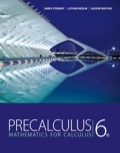
Concept explainers
Stopping Distance For a certain model of car the distance d required to stop the vehicle if it is traveling at v mi/h is given by the formula
where d is measured in feet. Kerry wants her stopping distance not to exceed 240 ft. At what range of speeds can she travel?

The range of speed for which the vehicle has stopping distance that do not exceed 240ft.
Answer to Problem 117E
The range of speed is
Explanation of Solution
The formula for distance to stop the car is
Substitute the value of 240ft for d in
Since the stopping distance is 240ft or less, the formula
On further simplification,
Further solve the equation as follows.
Thus,
Since the speed cannot be negative,
Therefore, the range of speed is
Chapter 1 Solutions
EBK PRECALCULUS: MATHEMATICS FOR CALCUL
- Let g(x) = f(t) dt, where f is the function whose graph is shown. y 5 f 20 30 t (a) Evaluate g(x) for x = 0, 5, 10, 15, 20, 25, and 30. g(0) = g(5) = g(10) = g(15) =| g(20) = g(25) = g(30) = (b) Estimate g(35). (Use the midpoint to get the most precise estimate.) g(35) = (c) Where does g have a maximum and a minimum value? minimum x= maximum x=arrow_forwardQuestion Determine lim f(x) given the definition of f(x) below. (If the limit does not exist, enter DNE.) x+6+ -2x²+3x-2 f(x) -2x-1 if x-5 if -−5≤ x ≤ 6 3 if x 6arrow_forwardQuestion Given the following piecewise function, evaluate lim f(x). (If the limit does not exist, enter DNE.) x-3 Provide your answer below: x² + 3x 3 if x-3 f(x) -3 if -3x -2x²+2x-1 6 if x 6arrow_forward
- Question Given the following piecewise function, evaluate lim f(x). x→2 Select the correct answer below: -73 -24 -9 -12 The limit does not exist. 2x f(x) = -2x²-1 if -2x2 3x+2 if x 2arrow_forwardQuestion Given the following piecewise function, evaluate lim f(x). f(x) = x+1- -2x² - 2x 3x-2 2 x² +3 if x-2 if -2< x <1 if x 1 Select the correct answer below: ○ -4 ○ 1 ○ 4 The limit does not exist.arrow_forwardQuestion Given the following piecewise function, evaluate lim →1− f(x). Select the correct answer below: ○ 1 ○ 4 -4 The limit does not exist. -2x² - 2x x 1arrow_forward
- (4) (8 points) (a) (2 points) Write down a normal vector n for the plane P given by the equation x+2y+z+4=0. (b) (4 points) Find two vectors v, w in the plane P that are not parallel. (c) (2 points) Using your answers to part (b), write down a parametrization r: R² — R3 of the plane P.arrow_forward(2) (8 points) Determine normal vectors for the planes given by the equations x-y+2z = 3 and 2x + z = 3. Then determine a parametrization of the intersection line of the two planes.arrow_forward(3) (6 points) (a) (4 points) Find all vectors u in the yz-plane that have magnitude [u also are at a 45° angle with the vector j = (0, 1,0). = 1 and (b) (2 points) Using the vector u from part (a) that is counterclockwise to j, find an equation of the plane through (0,0,0) that has u as its normal.arrow_forward
- (1) (4 points) Give a parametrization c: R R³ of the line through the points P = (1,0,-1) and Q = (-2, 0, 1).arrow_forward4. Consider the initial value problem y' = 3x(y-1) 1/3, y(xo) = yo. (a) For what points (co, yo) does the IVP have a solution? (b) For what points (xo, yo) does the IVP have a unique solution on some open interval that contains 20? (c) Solve the IVP y' = 3x(y-1) 1/3, y(0) = 9 and determine the largest open interval on which this solution is unique.arrow_forwardFind the limit. (If the limit is infinite, enter 'oo' or '-o', as appropriate. If the limit does not otherwise exist, enter DNE.) lim X→ ∞ (✓ 81x2 - 81x + x 9x)arrow_forward
 Calculus: Early TranscendentalsCalculusISBN:9781285741550Author:James StewartPublisher:Cengage Learning
Calculus: Early TranscendentalsCalculusISBN:9781285741550Author:James StewartPublisher:Cengage Learning Thomas' Calculus (14th Edition)CalculusISBN:9780134438986Author:Joel R. Hass, Christopher E. Heil, Maurice D. WeirPublisher:PEARSON
Thomas' Calculus (14th Edition)CalculusISBN:9780134438986Author:Joel R. Hass, Christopher E. Heil, Maurice D. WeirPublisher:PEARSON Calculus: Early Transcendentals (3rd Edition)CalculusISBN:9780134763644Author:William L. Briggs, Lyle Cochran, Bernard Gillett, Eric SchulzPublisher:PEARSON
Calculus: Early Transcendentals (3rd Edition)CalculusISBN:9780134763644Author:William L. Briggs, Lyle Cochran, Bernard Gillett, Eric SchulzPublisher:PEARSON Calculus: Early TranscendentalsCalculusISBN:9781319050740Author:Jon Rogawski, Colin Adams, Robert FranzosaPublisher:W. H. Freeman
Calculus: Early TranscendentalsCalculusISBN:9781319050740Author:Jon Rogawski, Colin Adams, Robert FranzosaPublisher:W. H. Freeman
 Calculus: Early Transcendental FunctionsCalculusISBN:9781337552516Author:Ron Larson, Bruce H. EdwardsPublisher:Cengage Learning
Calculus: Early Transcendental FunctionsCalculusISBN:9781337552516Author:Ron Larson, Bruce H. EdwardsPublisher:Cengage Learning





